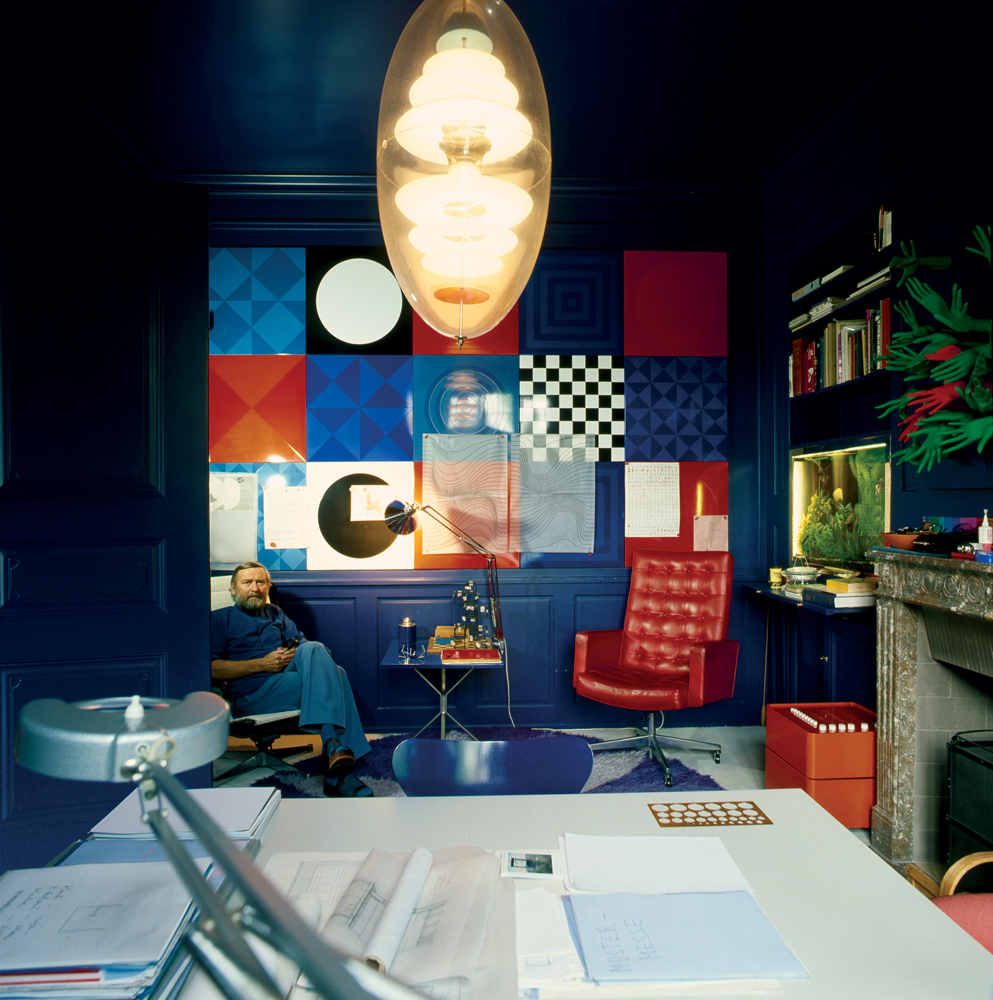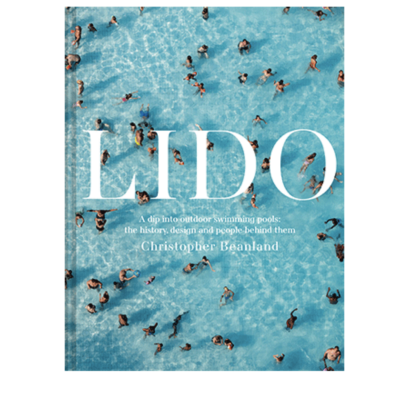Verner Panton
The Danish Architect and Designer who took a Generation on a Psychedelic Trip
‘One sits more comfortably on colours one likes’

Restaurant Varna, Arhus Design by Verner Panton ©Verner Panton Design AG
When international design mavens first saw Panton’s universe in ’58, it stopped them in their tracks. It was a game-changer.
Panton was a pioneer, his ‘whole world’ approach an uncompromising break with the convention. Fascinated by ‘colour psycologie’ from early on, and more than a little obsessed with blue, Panton used colour as a tool applied to his geometric forms and layered patterns creating something worthy of the space age.
Privathaus Binningen,Switzerland Design by Verner Panton, ©Verner Panton Design AG
Born in Brahesborg-Gamtofte on the island of Fünen in Denmark in 1926, educated at the Odense Technical School, Panton graduated as an architect from the Royal Academy of Arts in Copenhagen. There he met Tove Kemp, the step-daughter of architect and designer, Poul Henningsen. While their marriage was short-lived, Verner’s relationship with Poul Henningsen continued, creatively and personally, throughout his life.

Light and Colour Trapholt Museum 1998 Photo Poul Ib Henriksen ©Verner Panton Design AG
Fresh from the academy, two years in Arne Jacobsen’s design office followed, which could have been route one to a predictable career, working with one of Denmark’s most highly respected designers, but Verner was anything but conventional. Perhaps he was a product of his age, a designer growing up in the immediate aftermath of the War, acting on his vision with urgency rather than waiting for a right moment to present his idea, a moment that might never come. That energy translated into his designs, they demanded then and demand now, immediate attention.
Panton left Jacobsen in 1952 to embark on a series of road trips with Hans Ove Barfoed, criss-crossing Europe in a VW camper van doubling as his draughtsman’s office, a pre-digital nomad. The trips were highly productive laying the foundation for lifelong business relationships. Connections were forged with the highly respected firm Fritz Hansen who produced Panton’s Bachelor chair and Tivoli chair, another with Louis Poulsen the lighting company.

Trapholt Museum, Verner in his Cone Chair: Design by Verner Panton © Verner Panton Design AG
It was Panton’s father, the manager of a successful traditional, if somewhat sleepy, inn, who, determined to find a public showcase for his son’s vision, commissioned his son to redesign and extend the Kom Igen Inn on the Island of Fünen in 1958. And ‘come again‘ they did, in their droves. Verner designed every aspect right down to the staff uniforms and in the process launched the Cone Chair and very particular geometric hanging lamps. Frankly the designs knocked the socks off the design world; a commission from the Astoria Hotel in Trondheim Norway swiftly followed – allowing Verner to create a fabulous futuristic ‘total environment’ with curvy transparent plastic furniture, carpet, foam shaped forms, curtains and lighting.

Restaurant Varna, Arhus, Design by Verner Panton, Design by Verner Panton ©Verner Panton Design AG
Panton’s visionary aesthetic was spreading, his rise meteoric, he had devised a whole new language that spoke to a generation.
‘The main purpose of my work is to provoke people into using their imagination and make their surroundings more exciting’
Anyone who had the good fortune to visit or work in a space that had been subjected to the Verner Panton makeover was in for a fully immersive, almost trippy assault for all the senses – think that Oasis song ‘slowly walking down the hall faster than a cannonball.’ Verner’s world was not the exclusive the domain of the rich. His designs spread and flowed into every aesthetic nook informing product design at all price points, internationally.

Der Spiegel Cantine Design by Verner Panton© Verner Panton Design AG
Mathias Remmele, the author of Vernon Panton, the collected works, noted, ‘In the 1960s, Stern was among the best-known consumer magazines with the highest circulation in West Germany … in 1962, Stern evidently found Verner Panton’s furniture collection developed with Storz&Palmer so interesting and indeed pioneering that it featured these pieces in a multi-page extravaganza. Verner Panton himself was exclusively commissioned to be part of the photographs. The result remains impressive to this day. Not only, but also, because Marianne Panton appeared as a model – a part she was to play on several future occasions. And Panton? He meanwhile succeeded in smuggling a few more of his designs into the pictures. Those with eyes to see will recognize the Topan lamp, the Barboy and the Studioline furniture system.’
It must have been a blast to be in Verner’s creative orbit. Two stand outs are the installation for the Chemistry Company Group at the 1968 Cologne Furniture Fair which offered up Visiona O nicknamed the Dralon Ship, a boat on the Rhine extravagantly fitted out in dralon fabric for pharmaceutical company Bayer AG, and the interior design of offices for German publishing house Spiegel in 1969.

Visiona 2 1970, for Bayer textiles Design by Verner Panton ©Verner Panton
Panton’s revolutionary work translated into a career punctuated by awards and plaudits for designs immediately recognisable today more than 60 years later.
Today the Panton brand is looked after by Carin, Verner’s daughter, and his wife and life-long design collaborator Marianne Pherson-Oertenheim. Carin was brought up in what might be called a ‘Vernovision’ in the Binningen neighbourhood of Basle. A ‘room high live-in sculpture’ (today part of the permanent collection at the Pompidou) created in ’72 for the Kill Company, and was later placed in the family’s home in Binnengen.

Privathaus Binningen,Switzerland Arhus, Design by Verner Panton, ©Verner Panton Design AG

Privathaus Binningen,Switzerland Design by Verner Panton, ©Verner Panton Design AG
The energy Verner Panton created and applied as he experimented with form, colour, pattern and texture continued for another twenty years until his passing in 1998, a matter of days before an exhibition featuring his Light and Colour design project was due to open.
Selection of projects
Weekend family home 1957 with an update in the ’70s
Astoria hotel in Trondheim, Norway 1960
Varna restaurant near Arhus, Denmark 1970
Spiegel Magazine offices, canteen, swimming pool 1968-9
Guner and Jahr publishing house Hamburg, Germany 1973
Mira X Switzerland

Cirkusbygningen Copenhagen Verner Panton Design AG ©Verner Panton Design AG
Just some of those designs ….
Series K Kraemmerhusstole 1959 produced by Danish company
Cone Chair 1960 (later developed outside Denmark with Vitra).
Shell lamp 1964 introduced at Heimtex in Frankfurt
Flying Chair 1964 International Furniture Fair Cologne
S Chair 1956
Flower Pot Lamp
Landscaped interior for Kaufhof 1965
Use of Dralon plastic fabric for Bayer
Viebert chair for IKEA 1993
Pantoflex and Panto Swing chairs 1994
Awards
International Design Award three times and others too numerous to detail!
All images the Copyright of Verner Panton Design AG ©Verner Panton Design AG
Find out more about Verner Panton designs www.verner-panton.com
Exhibitions
A segment of the Spiegel-Verlag Canteen is held in the permanent collection of Museum für Kunst & Gewerbe Hamburg





















